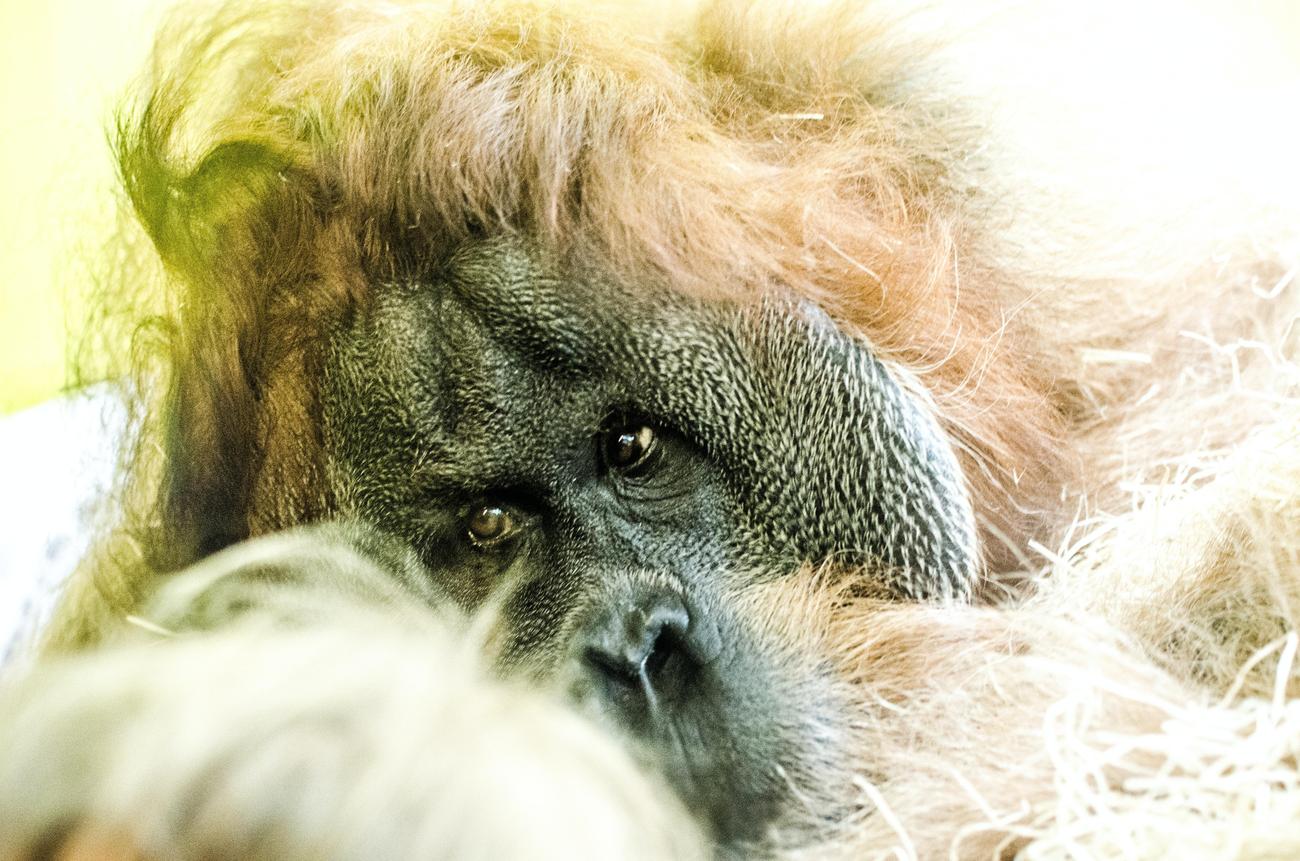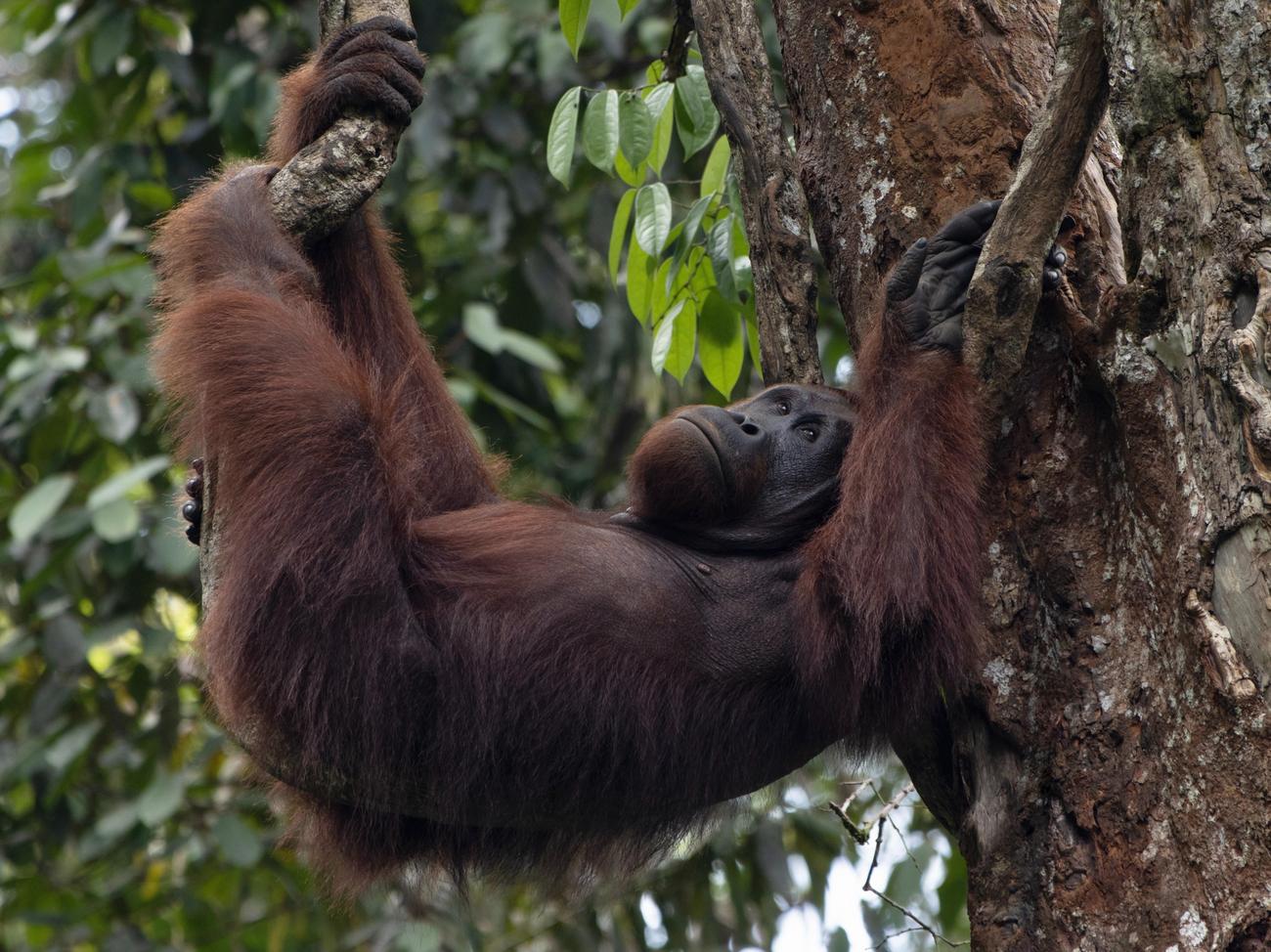Get ready to delve into the fascinating world of orangutans, where captivating facts and intriguing insights await. In this article, we will uncover the secrets of these remarkable creatures, from their incredible ability to learn everything they need to know from their mothers to their title as the heaviest tree-dwelling animal. As a seasoned wildlife enthusiast and expert in primate behavior, I am thrilled to share my wealth of knowledge and ignite your curiosity about the endangered orangutans. So, buckle up and prepare to be amazed by the wonders of these intelligent creatures!

Interesting Facts About Orangutans
Orangutans, fascinating primates found only in Southeast Asia, have captured the awe and curiosity of researchers and wildlife enthusiasts alike. With their striking resemblance to humans and their intriguing behaviors, these incredible creatures offer a world of captivating facts that shed light on their unique characteristics and their critical status as an endangered species.
1. Orangutans and Human Connection
One of the most astonishing facts about orangutans is their genetic similarity to humans. In fact, orangutans share an incredible 97% of their DNA with us. This striking resemblance highlights the evolutionary connections between our species and underlines the importance of protecting these remarkable creatures.
“The genetic affinity between humans and orangutans underscores the intricate and delicate balance of nature, urging us to appreciate and conserve these vulnerable primates.”
2. The Three Species of Orangutans
While orangutans might seem like a unified group, there are actually three distinct species—Sumatran, Bornean, and Tapanuli. Each of these species possesses unique traits and adaptations that allow them to thrive in different habitats and ecosystems.
“Diving deeper into the world of orangutans, we encounter not one, but three distinct species, each with its own captivating story to tell.”
3. Critical Endangerment
An alarming fact surrounding orangutans is their critically endangered status according to the International Union for Conservation of Nature (IUCN). This vulnerable classification underscores the urgent need for conservation efforts to protect these magnificent primates from extinction.
“The critical endangerment status of orangutans urges us to take immediate action, preserving not only their existence but also the rich biodiversity of our planet.”
4. Largest Tree-Living Mammal
Orangutans hold the impressive title of being the largest tree-living mammals in the world. Their long, muscular arms and strong limbs enable them to navigate the dense canopies of the rainforest with remarkable agility and grace.
“As we delve deeper into the realm of orangutans, we encounter a mammalian giant, gracefully traversing the treetops with unmatched poise and dexterity.”
5. A Fruity Palate
Orangutans are known for their diverse diet, consuming over 300 different types of fruit. This varied palate allows them to capitalize on the abundance of fruit available in their rainforest habitats and adapt their diet according to seasonal changes.
“With an unparalleled zest for fruity delights, orangutans navigate the rainforest’s luscious buffet as they savor a staggering variety of over 300 fruits.”
6. Arm-Length Travel
A fascinating adaptation that sets orangutans apart is their exceptionally long arms. These limbs, which can stretch up to 8 feet, serve as versatile tools for travel and help orangutans swing effortlessly from tree to tree, covering great distances in their habitats.
“Like nature’s acrobats, orangutans employ their remarkable appendages as they traverse the rainforest canopy, their long arms propelling them through the trees with incredible grace.”
7. Male Cheek Pads
Male orangutans develop large cheek pads, or flanges, on their faces as they reach adulthood. These distinctive facial features serve as a sign of dominance and help attract mates during the breeding season.
“In a remarkable display of evolutionary prowess, male orangutans flourish vibrant cheek pads, symbolizing their maturity and authority within the realm of these majestic primates.”
8. The Wisdom of Age
Orangutans are known for their longevity, with some individuals living up to 60 years or more. These wise, experienced creatures offer glimpses into the intricate lives and social dynamics that shape orangutan communities.
“As the days turn into decades, orangutans illuminatingly embody the wisdom and resilience that come with age, inviting us to cherish the interconnectedness of all life.”
9. Deforestation: A Looming Threat
Regrettably, deforestation poses the most significant threat to orangutans. As their natural habitats are destroyed to make way for agriculture and development, these remarkable creatures confront the heartbreaking reality of losing their homes and struggling for survival.
“The specter of deforestation looms menacingly over orangutans, reminding us of the urgency to preserve these invaluable rainforests that serve as their sanctuary.”
Orangutans, with their captivating facts and unique personalities, offer a glimpse into the wonders of the natural world. By immersing ourselves in their remarkable lives, we not only enrich our understanding of these incredible primates but also deepen our appreciation for the delicate balance of nature. It is upon each of us to champion their cause, ensuring that these captivating facts continue to exist for generations to come.
“Through the lens of these fascinating insights, we glimpse the captivating world of orangutans—a world that invites us, with open arms, to protect and cherish the biodiversity that thrives within our planet’s precious rainforests.”
Interested in learning fun facts about orangutans? Look no further! Our article, “Interesting Facts About Orangutans,” delves deep into the fascinating world of these incredible creatures. From their unique habitats and striking appearances to the reasons behind their endangered status, this article covers it all. But that’s not all! We also have fun facts about sumatran orangutans, bornean orangutans, and even cool facts about orangutans in general. Click here to discover the amazing world of orangutans and their habitats: fun facts about sumatran orangutans, interesting facts about orangutans habitat, what do orangutans look like, why are orangutans endangered, fun facts about bornean orangutans, and cool facts about orangutans.
They Learn Everything They Need to Know from Mum
Orangutans, those magnificent red-haired apes that inhabit the lush rainforests of Southeast Asia, have a unique way of passing on knowledge and skills to the younger generation. In fact, they learn everything they need to know from their mothers, who act as their primary teachers and guides in the complex world of the jungle. Let’s dive into the captivating process of orangutan learning and discover the incredible bond between mother and child.
From the moment they are born, baby orangutans rely entirely on their mothers for survival. Female orangutans give birth about once every eight years and invest a great deal of time and effort in raising their offspring. These devoted mothers carry their babies for the first few years, providing constant nourishment and protection. As the infants grow older, they begin to observe and imitate their mothers’ behaviors, gradually learning essential skills for survival.
The mother orangutan serves as a living encyclopedia, offering a vast array of knowledge to her curious offspring. She teaches them everything from finding food and identifying ripe fruits to building nests for sleeping and using tools. Through attentive observation, young orangutans learn the intricate art of foraging, becoming adept at selecting the juiciest fruits or extracting insects from tree bark. They master the technique of using sticks to scratch their backs or open nuts, showcasing their capability for tool use.
“The bond between an orangutan mother and her child is astounding. It’s a relationship built on trust, love, and the transfer of invaluable wisdom.”
This remarkable learning process is not limited to practical skills; it extends to social behaviors and communication as well. Baby orangutans observe their mothers’ interactions with other orangutans, acquiring the subtleties of body language, vocalizations, and facial expressions that enable them to navigate social dynamics within their community. They learn to read the mood of their fellow orangutans, understand dominance hierarchies, and establish their own place in the intricate social tapestry of the forest.
“Just like human children, young orangutans absorb knowledge from their mothers like sponges, preparing themselves to become independent individuals in the vast rainforest.”
The duration of the learning period is quite substantial. Orangutan infants stay with their mothers for six to seven years, which is longer than any other non-human primate. During this extended period, the mother teaches her offspring the intricate skills necessary for survival in the wild. She ensures that they are fully equipped to navigate the challenges of the forest and thrive on their own once they are ready to venture out into the world.
“The patience and dedication of orangutan mothers are truly awe-inspiring. Their guidance and teachings lay the foundation for their offspring’s future success.”
Understanding the pivotal role of orangutan mothers in shaping the next generation brings us closer to appreciating the intricate web of relationships within these rainforest dwellers. As we delve deeper into their world, we uncover the profound intelligence and adaptability hidden behind their endearing faces.
Whether it’s imitating fruit selection, perfecting tool usage, or navigating intricate social dynamics, orangutans demonstrate their ability to learn and adapt through their remarkable mother-offspring bond. It is a testament to the intricate web of life in the rainforest and the incredible creatures that call it home.
“The mother’s role as a teacher and nurturer remains a cornerstone of orangutan society, underscoring the crucial importance of protecting these magnificent creatures and their rainforest habitat.”
So next time you catch a glimpse of an orangutan swinging effortlessly through the treetops, take a moment to appreciate the depth of knowledge that lies behind those expressive eyes. Look beyond their playful antics and recognize the wealth of information they have acquired, thanks to the tireless efforts of their mothers. Orangutans truly embody the saying, “Home is where Mom is.”
(Word count: 658)
Orangutans are the Heaviest Tree-Dwelling Animal
Orangutans, the magnificent creatures of the rainforest, hold a remarkable title: they are the heaviest tree-dwelling animals on our planet. Picture an adult male orangutan, standing tall at 5 feet and weighing up to a whopping 300 pounds. That’s the weight of a grand piano! Females, although smaller, are still impressive at 3.5 feet and weighing between 100 to 150 pounds on average. These exceptional dimensions are a testament to their adaptation for life in the treetops.
As seasoned wildlife enthusiasts, we are in awe of the remarkable physical prowess of orangutans. They spend the majority of their lives swinging through the lush canopies, making use of their muscular limbs and immense strength. Imagine navigating such an intricate web of branches with such grace and agility! It’s no wonder they need vast stretches of forest to find enough food and mates.
Orangutans’ impressive size and strength allow them to navigate the dense canopies with ease, making them the heaviest tree-dwelling animal on Earth.
Unfortunately, the grandeur of these marvelous primates is overshadowed by the looming threats they face. Deforestation and hunting are the two biggest enemies of orangutans. Their habitat is being destroyed at an alarming rate, robbing them of the lush forests they depend on for survival. As we raise awareness about these issues, it is crucial that we appreciate the significance of the orangutan’s status as the heaviest tree-dweller and its implications for their conservation.
The urgent need to protect orangutans becomes even more evident when we consider their vulnerable status as the heaviest tree-dwelling animals and the challenges they face due to deforestation and hunting.
While orangutans currently reside in the Indonesian islands of Borneo and Sumatra, they once roamed across a much larger territory. From southern China to the islands of Java and Sumatra, their presence was felt far and wide. It is now crucial to protect and conserve the pockets of their remaining habitat, such as the Ruvuma Transboundary Landscape, which serves as a vital haven for these incredible creatures.
The decline in orangutan populations and the restriction of their habitat highlights the importance of cherishing and safeguarding their remaining strongholds, such as the Ruvuma Transboundary Landscape.
Orangutans, with their imposing size, captivate us not only physically but also intellectually. Did you know that up to 90% of their diet consists of fruit? Their love for fruits not only enriches their lives but also plays a crucial role in shaping the environment by dispersing seeds far and wide. By sharing this fascinating fact, we can deepen our understanding of their ecological significance.
The orangutan’s diet, consisting primarily of fruits, establishes their critical role as seed dispersers, contributing to the remarkable diversity of their forest habitats.
In addition to their diet, orangutans also display incredible ingenuity when it comes to their nests. They construct highly-engineered arboreal abodes, meticulously weaving branches and leaves into a comfortable bed high up in the treetops. Spending a significant amount of time in their nests, orangutans create a unique and safe haven for rest and relaxation.
Orangutans’ extraordinary ability to build intricate nests demonstrates their resourcefulness and adaptability in their tree-dwelling lifestyle.
Through these glimpses into the extraordinary world of orangutans, we uncover mesmerizing facts that leave us in awe. Their immense size and strength, their crucial role in seed dispersal, and their ingenious nest-building skills all contribute to an enchanting narrative that deserves to be shared far and wide. By appreciating the captivating facts surrounding orangutans, we can inspire a deeper understanding and a stronger commitment to their conservation.
The captivating world of orangutans, their physical prowess, and their ecological roles invite us to delve deeper into their lives, fostering a sense of wonder and an urgent need to protect their fragile existence.
Let us embark on a journey of discovery as we unveil even more intriguing insights into the unique behavior, intelligence, and endangered status of orangutans – the heaviest tree-dwelling animal. Together, let us celebrate their greatness and work towards securing a future where these majestic creatures can thrive.
FAQ
Q: Do orangutans learn everything they need to know from their mothers?
A: Yes, orangutans learn important survival skills from their mothers.
Q: Are orangutans the heaviest tree-dwelling animals?
A: Yes, orangutans are the heaviest tree-dwelling animals.
Q: What are the biggest threats to orangutans?
A: The biggest threats to orangutans are deforestation and hunting.
Q: How big can adult male orangutans grow?
A: Adult male orangutans can grow up to 5 feet tall and weigh as much as 300 pounds.
Q: What is the average lifespan of an orangutan?
A: Orangutans can live up to 45 years, or even longer in captivity.
- Jerry McSorley’s Post-Divorce Life: New Beginnings - July 16, 2025
- The Rise and Fall of the New Haven Nighthawks: A Minor League Hockey Legacy - July 16, 2025
- Unlock Jerry McSorley’s Career Highlights: Eye Tax Inc.’s Solar Success - July 16, 2025
















